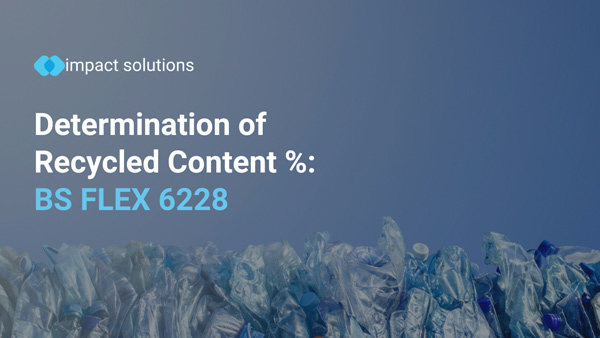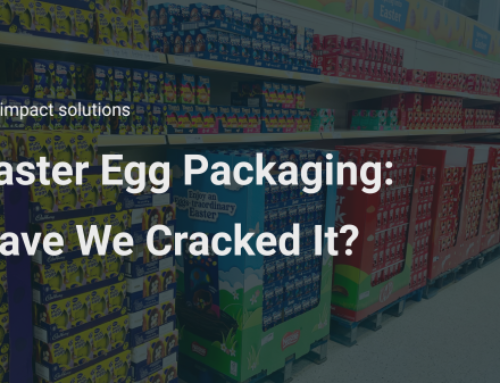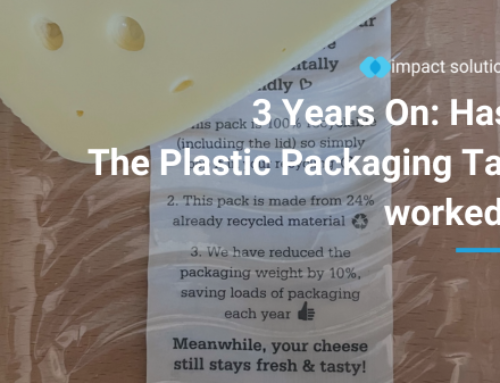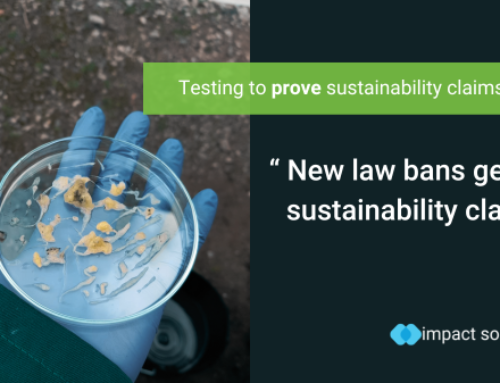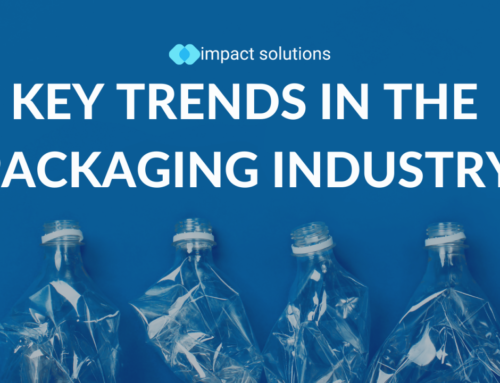Developing BS Flex 6228 standard to measure % recycled content in plastic packaging
Introduction
The government has introduced a Plastic Packaging Tax (PPT) designed to increase the use of recycled material in the production of plastic packaging. A tax of £200 per tonne is levied on packaging that does not have at least 30% recycled plastic content. In order to police the PPT companies will be required through supply chain auditing to provide evidence that packaging produced does contain ≥ 30% recycle content.
Impact Solutions has been working with BSI to develop a Flex Standard (BS Flex 6228) to determine whether a PET product has >30% recyclate in it. The Flex Standard does not replace supply chain auditing, rather it offers a screening method to test whether the properties of a sample are consistent with its claimed level of recyclate. It also does not provide methods to determine the quality of the packaging, and/or its suitability for a specific purpose, such as containing food or drink.
Impact are currently working with polyethylene and polypropylene packaging to extend the scope to a wider range of packaging.
Plastic packaging – Assessment of recycled content within polyethylene terephthalate (PET) virgin material and recyclate blended packaging materials produced from mechanical recycling methods – Specification and test methods.
The BS Flex 6228 covers rigid forms of PET packaging with:
- recyclate (i.e. polymers that have been used commercially and have been returned for re-use through waste collection), it does not cover regrind (i.e. material used during processing and recycled internally within a production facility for blending with virgin polymers).
- recyclate produced through mechanical recycling methods from plastic waste streams not from chemical recycling methods.
- translucent or transparent properties but not coloured or opaque products.
It also covers recycled content within PET pellets created from waste streams for use as a raw material from which plastic packaging will be created.
The BS Flex 6228 model has been developed using 75 different rPET/PET products from 14 separate manufacturers.
The model for predicting the presence and levels of recycled rPET present in PET packaging products is empirically derived from a combination of the following tests undertaken on each of the 75 samples.
- Thermal (DSC/TGA) to determine the crystallization temperature on cooling
- Colourimetry to measurement of tristimulus property L*
- UV-visible spectrometry to measure the transmission and absorbance
The standard enables (i) the determine of the probability that rPET% content in the product is greater than 30%, and (ii) to calculate the recycled content when the virgin and recycled feedstocks are available.
Determination that the rPET% >30%
The probability that the recycled content is 30% or greater is determined using the following calculations:
P rPET>30% = exp (B)
(1+exp (B))
Where:
B = B0 +B1 AN678nm + B2 T p,c,C + B3 L* and the coefficients are shown in Table 1.

AN678nm = The normalised absorbance at 678nm determined from the mean transmission at 678nm and average thickness using the Beer-Lambert law.
T p,c,C = The mean crystallisation temperature on cooling
L* = The mean lightness
The probability is said to indicate a recycled content of ≥ 30% if P rPET>30% is ≥ 0.3..
Calculation to determine the recycle content by comparison with the properties of virgin and recycled feedstock
The determination of recyclate content is determined using UV-vis transmission measurements at 350nm on both virgin and recycled materials and samples from those batches used to manufacture the sample of interest. It takes advantage of the fact that blends of the virgin with the recycle shows linearity as shown in the figure below.
Figure showing normalised absorbance values at 350nm for three sets of films produced with different recyclate at various recycled content levels.

The recycled material absorbance normalised to account for thickness is calculated as
where:
|
AN100%rPET,350nm |
is the normalised absorbance of 100% recycled PET feedstock at 350nm (referenced to the transmission value of the virgin PET feedstock); in AU/mm; |
and the thickness of normalised absorbance of the sample of interest shall be calculated as:

where:
|
ANsPET,350nm |
is the normalised absorbance of the sample at 350nm (referenced to the transmission value of the virgin PET feedstock) in AU/mm; |
The inferred level of the recycled content in the sample shall then be calculated as:

where:
| rPET% inferred |
is the inferred percentage of recycled material in the sample expressed in percent. |
For more details on the calculations and their accuracy refer to the Flex 6228.
Get in touch today to learn how you can protect your brand and verify your content now: contact us //+44(0)1324 489182

